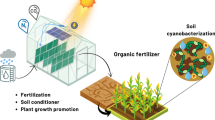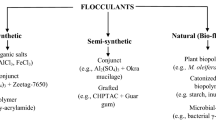Abstract
Nowadays, artificial construction of bacteria-algae consortia to enhance microalgal biomass is prevalent in enclosed systems, while few are built in an open culture. In this study, Achromobacter sp. and Rhizobium sp., isolated from an open pond of Chlorella sorokiniana, were the microalgal growth-promotion bacteria and selected to build the bacteria–algae consortia with axenic C. sorokiniana in open cultivation systems. To examine the performance of these two artificial bacteria–algae consortia in open culture under stable cultivation conditions, the co-cultivation experiments were conducted under constant temperature and light intensity indoors. It was found that Achromobacter sp. gradually lost the dominance of the population in the co-culture and failed to promote the growth of C. sorokiniana during open cultivation. However, the Rhizobium sp. maintained its dominant population of bacterial community in open culture and could promote the growth of C. sorokiniana, with an enhancement of 13.76%. To further evaluate the effects of Rhizobium sp. on microalgae under variations of temperature and sunlight intensity conditions, the open co-cultivation experiments were built outdoors. Results showed that the growth of C. sorokiniana could rise 13.29% only when Rhizobium sp. was added to the culture continuously, and addition of bacterial solution in log-phase of microalgae could help Rhizobium sp. dominate in the bacterial community. In this way, addition of Rhizobium sp. in the log-phase of C. sorokiniana should be an effective process to be applied to open ponds cultivation. Our findings are a step toward applying growth-promotion bacteria for C. sorokiniana for applications in open cultivation systems.









Similar content being viewed by others
References
Li Y, Horsman M, Wang B, Wu N, Lan CQ (2008) Effects of nitrogen sources on cell growth and lipid accumulation of green alga Neochloris oleoabundans. Appl Microbiol Biotechnol 81(4):629–636
John RP, Anisha GS, Nampoothiri KM, Pandey A (2011) Micro and macroalgal biomass: a renewable source for bioethanol. Bioresour Technol 102(1):186–193
Brennan L, Owende P (2010) Biofuels from microalgae—a review of technologies for production, processing, and extractions of biofuels and co-products. Renew Sustain Energy Rev 14(2):557–577
Griffiths MJ, Harrison STL (2009) Lipid productivity as a key characteristic for choosing algal species for biodiesel production. J Appl Phycol 21(5):493–507
Ramanan R, Kim B-H, Cho D-H, Oh H-M, Kim H-S (2016) Algae–bacteria interactions: evolution, ecology and emerging applications. Biotechnol Adv 34(1):14–29
Hernandez J-P, de-Bashan LE, Rodriguez DJ, Rodriguez Y, Bashan Y (2009) Growth promotion of the freshwater microalga Chlorella vulgaris by the nitrogen-fixing, plant growth-promoting bacterium Bacillus pumilus from arid zone soils. Eur J Soil Biol 45(1):88–93
Cho D-H, Ramanan R, Heo J, Lee J, Kim B-H, Oh H-M, Kim H-S (2015) Enhancing microalgal biomass productivity by engineering a microalgal–bacterial community. Biores Technol 175:578–585
Dao G-H, Wu G-X, Wang X-X, Zhang T-Y, Zhan X-M, Hu H-Y (2018) Enhanced microalgae growth through stimulated secretion of indole acetic acid by symbiotic bacteria. Algal Res 33:345–351
Wang R, Xue S, Zhang D, Zhang Q, Wen S, Kong D, Yan C, Cong W (2015) Construction and characteristics of artificial consortia of Scenedesmus obliquus-bacteria for S. obliquus growth and lipid production. Algal Res 12:436–445
Cole JJ (1982) Interactions between bacteria and algae in aquatic ecosystems. Annu Rev Ecol Syst 13(1):291–314
Pengerud PF, Pengerud B (1985) Fate and effect of allochthonous organic material in aquatic microbial ecosystems: an analysis based on chemostat theory. Mar Ecol Prog Ser 21(1):47–62
Grossart HP (1999) Interaction between marine bacteria and axenic diatoms. Aquat Microb Ecol 19:1–11
Vessey JK (2003) Plant growth promoting rhizobacteria as biofertilizers. Plant Soil 255(2):571–586
Liu Z, Qiuqian L, Yao Z, Wang X, Huang L, Zheng J, Wang K, Li L, Zhang D (2018) Effects of a commercial microbial agent on the bacterial communities in shrimp culture system. Front Microbiol 9:e2430
Zhang C, Yu Z, Zhao J, Zhang H, Zhai Q, Chen W (2019) Colonization and probiotic function of Bifidobacterium longum. J Funct Foods 53:157–165
Fierer N, Jackson JA, Vilgalys R, Jackson RB (2005) Assessment of soil microbial community structure by use of taxon-specific quantitative PCR assays. Appl Environ Microbiol 71(7):4117–4120
Perez-Jaramillo JE, de Hollander M, Ramirez CA, Mendes R, Raaijmakers JM, Carrion VJ (2019) Deciphering rhizosphere microbiome assembly of wild and modern common bean (Phaseolus vulgaris) in native and agricultural soils from Colombia. Microbiome 7(1):114
McMurdie PJ, Holmes S (2013) phyloseq: an R package for reproducible interactive analysis and graphics of microbiome census data. PLoS ONE 8(4):e61217
Watanabe K, Takihana N, Aoyagi H, Hanada S, Watanabe Y, Ohmura N, Saiki H, Tanaka H (2005) Symbiotic association in Chlorella culture. FEMS Microbiol Ecol 51(2):187–196
Surendhiran D, Vijay M (2014) Exploration on bioflocculation of Nannochloropsis oculata using response surface methodology for biodiesel production. Sci World J 2014:202659
Kwak MJ, Jeong H, Madhaiyan M, Lee Y, Sa TM, Oh TK, Kim JF (2014) Genome information of Methylobacterium oryzae, a plant-probiotic methylotroph in the phyllosphere. PLoS ONE 9:e106704
Kim BH, Ramanan R, Cho DH, Oh HM, Kim HS (2014) Role of Rhizobium, a plant growth promoting bacterium, in enhancing algal biomass through mutualistic interaction. Biomass Bioenerg 69:95–105
Jin Zhou GC, Ying K, Jin H, Song J, Cai Z (2019) Phycosphere microbial succession patterns and assembly mechanisms in a marine dinoflagellate bloom. Appl Environ Microbiol 85:e00349-e01319
Hardin G (1960) The competitive exclusive principle. Science 131(3409):1292–1297
Buttigieg PL, Ramette A (2014) A guide to statistical analysis in microbial ecology: a community-focused, living review of multivariate data analyses. FEMS Microbiol Ecol 90(3):543–550
Sapp M, Schwaderer A, Wiltshire K, Hoppe H-G, Gerdts G, Wichels A (2007) Species-specific bacterial Communities in the phycosphere of microalgae? Microb Ecol 53(4):683–699
Bashan N (2016) Inoculant formulations are essential for successful inoculation with plant growth-promoting bacteria and business opportunities. Indian Phytopath 69(4s):739–744
Acknowledgements
This work was supported by the National Key R & D Program of China (2018YFD0401105) and Natural Science Foundation of China (21376246).
Author information
Authors and Affiliations
Corresponding author
Ethics declarations
Conflict of interest
The authors declare that they have no known competing financial interests or personal relationships that could have appeared to influence the work reported in this paper.
Additional information
Publisher's Note
Springer Nature remains neutral with regard to jurisdictional claims in published maps and institutional affiliations.
Supplementary Information
Below is the link to the electronic supplementary material.
Rights and permissions
About this article
Cite this article
Zhou, Z., Li, Q., Song, K. et al. Exploration of applying growth-promotion bacteria of Chlorella sorokiniana to open cultivation systems. Bioprocess Biosyst Eng 44, 1567–1576 (2021). https://doi.org/10.1007/s00449-021-02542-6
Received:
Accepted:
Published:
Issue Date:
DOI: https://doi.org/10.1007/s00449-021-02542-6




